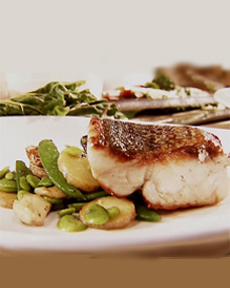TIP OF THE DAY: Cook Some Wild Striped Bass
|
|
Some fish get more respect than others. The media are filled with recipes for cod, halibut, trout, salmon, sea bass, snapper and tilapia.
What about the striped bass*, a coastal water denizen that happens to be the state fish of Maryland, Rhode Island and South Carolina, and the state saltwater fish of New Hampshire, New York and Virginia? Native to the coasts of eastern North America, the bass live as far north as the St. Lawrence River in Canada to the St. Johns River in northern Florida. They are also found throughout the northern Gulf of Mexico. Once fished to dangerously low levels, the population has recovered and is now found in record numbers. Right now, an abundance of wild striped bass from Maryland and Virginia are in markets. Plentitude means lower prices, so they’re a great buy. |
|
|
*Also called Atlantic striped bass, linesiders, rockfish and stripers, among other names. Fish Facts Striped bass are also farmed in a hybrid of striped bass and white bass. But there’s no need to look for farmed fish when the real deal is waiting for you. (See a discussion of the difference between wild and farmed fish.) Thanks to Euro USA Fresh Seafood for this ultra-easy recipe. Pair it with a sauvignon blanc or a Chablis. Ingredients 1. Take the fish out of the refrigerator 10 to 15 minutes before preparing. 2. Pat the skin dry with a paper towel and season the fish on both sides with salt and pepper. 3. Heat olive oil in a large sauté pan over high heat. 4. Coat the bottom of another slightly smaller sauté pan with olive oil (you can use a less expensive oil here—it’s just to keep the pan from burning). Gently place fish fillets skin side down in the larger sauté pan and place the smaller sauté pan directly on top of the fish. This technique creates a lovely crispy fish skin by gently pressing the skin of the bass onto the bottom of the sauté pan. 5. After a couple of minutes, remove the top sauté pan to allow steam to escape and the skin to become very crispy. 6. As fish cooks, it turns from translucent to opaque. Cook the fish two-thirds of the way on the skin side and flip it over for the last third of the cooking time. The rule for fish is about 7 to 8 minutes per inch of thickness, a little less if you like your fish more on the rare side (as we do!).
|
||



